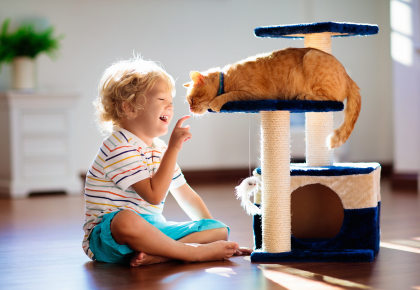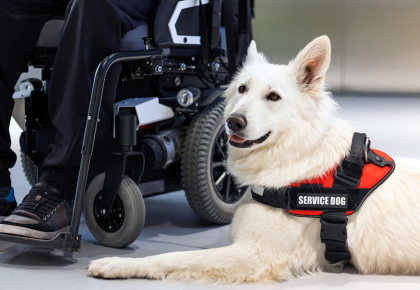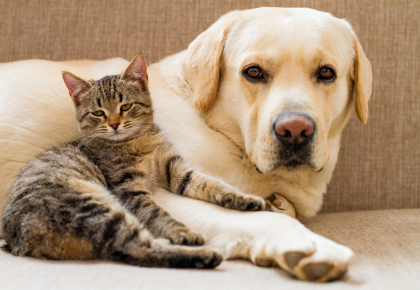 Most HOAs aren’t just made up of human residents. You can find a variety of four-legged residents as well! Furry friends are often a welcome addition, as they can liven up a community and improve the mental health of residents. However, they can also lead to disagreements, messes, property damage and in rare cases, injury.
Most HOAs aren’t just made up of human residents. You can find a variety of four-legged residents as well! Furry friends are often a welcome addition, as they can liven up a community and improve the mental health of residents. However, they can also lead to disagreements, messes, property damage and in rare cases, injury.
Making sure your human and pet residents can live together in your HOA in harmony is a challenge for many boards.
But the solution is easier than it seems. Have solid HOA pet policies in place. However, they need to be sensible and easy to follow. Read on as we breakdown what your HOA board needs to consider when creating sensible pet policies.
Understand the difference between a pet and a service animal
 Ahead of making rules around pets, it’s important to understand the difference between a pet and a service animal. For the purposes of creating rules for your community, pets are defined as companion animals. And they can provide emotional benefits to their owners, such as reducing stress or easing loneliness.
Ahead of making rules around pets, it’s important to understand the difference between a pet and a service animal. For the purposes of creating rules for your community, pets are defined as companion animals. And they can provide emotional benefits to their owners, such as reducing stress or easing loneliness.
Service animals are working animals. The Americans with Disabilities Act (ADA) classifies service animals as dogs of any breed or size that are trained to perform a task directly related to a person’s disability. The rights of those that require a service animal are protected by the ADA.
Should you have any concerns about the distinction between pets and service animals and how it impacts your community, speak with your association attorney.
Draft reasonable HOA pet policies
According to a recent Forbes article, 66% of U.S. households own a pet and 85% of dog owners and 76% of cat owners consider their pets to be a member of the family. With that in mind, you can be almost certain you’ve got some four-legged neighbors. And with solid pet policies in place, pets and owners can remain good neighbors and not a nuisance.
Most HOA boards have a few horror stories of poor pet/owner behavior within their HOA. This can make an outright ban on pets tempting. However, a pet-friendly community can be a huge selling point for many potential residents. Which is why clear and concise pet policies can go a long way in keeping pet issues to a minimum.
When drafting the rules, it’s important to remember that each one should have a purpose that is easy to define. Residents will be more inclined to follow a rule if they understand the reason it’s in place. To make sure you’re on the right track, discuss the potential rules with your legal counsel. They will be well versed in local and state laws you may need to consider.
HOA boards typically make rules around the following:
-
The number of pets permitted within a single dwelling or unit
-
Weight, size, or breed of animals
-
Areas where residents can keep or take pets
-
Requirements for where on the premises pets must be leashed
Before blindly implementing these kinds of rules, it’s important to consider if they can be fairly and reasonably enforced. For example, to keep larger animals out of the community, many HOAs want to put weight restrictions on animals. However, rules specific to an animal’s weight are not easy to enforce. Who is responsible for weighing all the pets throughout the HOA to ensure the rule is being followed? How often does weighing the HOA pets need to happen? If a dog gains a few pounds from a few too many treats and ends up over the weight limit, what happens?
As you can see, setting weight limits is not the easiest way to keep large animal breeds from moving in. Should your board decide it wants a rule about the specific types of animals and breeds that are allowed in the community, it’s easier to list what breeds and types of animals are and are not allowed. If you choose to set a rule about specific breeds, you should work closely with your attorney to craft it, making sure you aren’t creating a rule that will create strife within the community.
An example of a more common rule an HOA can put in place would be to state that an animal’s owner must clean any waste deposited in common areas, and refusal to do so would result in a fine. To make this rule easier for residents to follow, consider placing dog waste disposal units that include a bag dispenser in the common outdoor areas that pets are allowed to use.
A rule like this shows that your board is dedicated to keeping association grounds clean. And the addition of a pet amenity goes a long way in showing you consider pets a valuable part of your community.
To make sure your rules are written in such a way that they aren’t left open to interpretation, have your legal counsel review them.
Communication and compliance
Once your HOA’s pet rules are updated or drafted, communication to help ensure resident compliance is the next step.
 To keep put rules top of mind with residents, they need to be communicated often. We recommend using a variety of communication channels like email, newsletters, and posters to help get the message across to all residents. Because residents can’t comply with policies that they don’t know exist.
To keep put rules top of mind with residents, they need to be communicated often. We recommend using a variety of communication channels like email, newsletters, and posters to help get the message across to all residents. Because residents can’t comply with policies that they don’t know exist.
It should be noted that if your community has units that are rented out by the owner, they can have their own additional pet rules. For that reason, your communication should include a note to tenants that their pet rules may differ, and they are required to follow the rules set by their landlord.
Consistency and fairness in enforcing the rules will go a long way toward making sure all residents comply with them. When it comes to how complaint procedures are handled, you should work with your HOA’s attorney.
Exceptions can be made sparingly
Any rules regarding animals should be consistently enforced for the well-being of the HOA, but there are some exceptions boards must consider, particularly when first instituting new pet rules.
Let’s say after too many issues with pets your board has decided to become a no-pet community, however some residents already have existing pets. There is the option to “grandfather” them in so that the animals can remain with their families, and no one is forced from their homes. With this option, the updated rules must be well communicated to any new residents in order to avoid misunderstandings.
Lean on your legal counsel and HOA management team
Like with the creation of any rules for your HOA, there is a lot to consider when it comes to pet policies. However, because this is about resident’s furry family members, it’s often more complex and can be a sensitive issue for community members. That’s why it’s so important to work closely with your legal counsel when drafting the rules. They will help you create sensible rules that can be enforced, setting your HOA up for success.
And when it comes to communicating and enforcing the rules, it’s important you lean on the expertise of your HOA management team. They have the experience and tools to make communicating and enforcing the rules a breeze. Because reasonable pet policies can go a long way in keeping your human and four-legged residents happy.